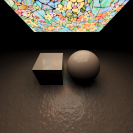Combining Analytic Direct Illumination and Stochastic Shadows

In this paper, we propose a ratio estimator of the direct-illumination equation that allows us to combine analytic illumination techniques with stochastic raytraced shadows while maintaining correctness. Our main contribution is to show that the shadowed illumination can be split into the product of the unshadowed illumination and the illumination-weighted shadow. These terms can be computed separately — possibly using different techniques — without affecting the exactness of the final result given by their product. This formulation broadens the utility of analytic illumination techniques to raytracing applications, where they were hitherto avoided because they did not incorporate shadows. We use such methods to obtain sharp and noise-free shading in the unshadowed-illumination image and we compute the weighted-shadow image with stochastic raytracing. The advantage of restricting stochastic evaluation to the weighted-shadow image is that the final result exhibits noise only in the shadows. Furthermore, we denoise shadows separately from illumination so that even aggressive denoising only overblurs shadows, while high-frequency shading details (textures, normal maps, etc.) are preserved.
Publication Date
Research Area
External Links
Uploaded Files
Copyright
Copyright by the Association for Computing Machinery, Inc. Permission to make digital or hard copies of part or all of this work for personal or classroom use is granted without fee provided that copies are not made or distributed for profit or commercial advantage and that copies bear this notice and the full citation on the first page. Copyrights for components of this work owned by others than ACM must be honored. Abstracting with credit is permitted. To copy otherwise, to republish, to post on servers, or to redistribute to lists, requires prior specific permission and/or a fee. Request permissions from Publications Dept, ACM Inc., fax +1 (212) 869-0481, or permissions@acm.org. The definitive version of this paper can be found at ACM's Digital Library http://www.acm.org/dl/.
